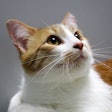Researchers from the University of Illinois interested in finding a method to maintain healthy body weight in cats have looked at a previously suggested claim that increased meal frequency could help to increase overall physical activity. The idea is to feed cats the appropriate amount of food needed to maintain a healthy body weight, but to offer it in more frequent, smaller meals throughout the day.
Animal sciences researcher Kelly Swanson and his lab at U of I determined that both increasing the frequency of meals fed per day, as well as offering meals that contained added dietary water-neither method involved decreasing the overall amount of daily food intake-did promote more physical activity among the cats in the study. "It all comes down to energy in and energy out," said Swanson. "It's very simple on paper, but it's not that easy in real life, especially in a household where there is more than one pet. That can be difficult, but I think these two strategies are very practical ideas that people can use."
During the two-part study, researchers evaluated the activity of the cats between meals using activity collar monitors. In the first experiment, the cats were divided among four rooms and were given dry kibble meals four times per day, two times per day, one time per day, and in the fourth room, were fed a random number of meals per day. The overall amount of food fed to each cat in each room per day was the same; feeding frequency varied.
In the second experiment, the cats were divided among two rooms and were fed twice per day with a 70% hydrated diet, using similar amounts of dry kibble used in the first experiment to maintain body weight. Water was added to the kibble an hour before each meal time, according to Swanson.
The cats were placed in their individual cages only during mealtimes so that the researchers could accurately monitor their food intake. During the activity monitoring times, the cats had limited interaction with people. The researchers evaluated the cats' food anticipatory activity (FAA), which included the activity of each cat two hours before meals were given. During the dry kibble experiment, they noticed that the cats were much more active during those anticipatory times, especially those fed four meals per day and those given meals at random times.
"If they know they are going to get fed, that's when they are really active, if they can anticipate it," said Swanson. The cats showed an even greater spike in physical activity in the second experiment when they were fed meals with the added water. However, Swanson said the biggest difference in peak activity times with this group occurred in the periods after they had eaten. He added that the researchers had not determined why this was, though factors such as increased use of the litter box, for example, could have come into play.
"I think veterinarians will be interested in this information because it gives them evidence to be able to recommend something to pet owners that could help with feline obesity and diabetes," said Swanson. "When cats are allowed to feed ad libitum, it's difficult to prevent obesity. It is important to identify the right diet. Many owners are accustomed to dumping a pile of food out for multiple cats, just once per day. The owner does have an active role in helping with weight management."
The key is figuring out how much food is needed to maintain your cat's healthy body weight. "It is tricky because labels on petfood provide ranges for how much should be fed," said Swanson. "If you're feeding a cat, that food is supplied to thousands of cats with different metabolism. Some are spayed or neutered, and ages are different."
Adding water to dry food, or using wet canned food, may provide a greater gut fill to pets. Swanson also said once the dry kibble absorbs the water, it does look like "more" to the owner, perhaps alleviating the fear that the pet is not eating enough. He also said that rotating between dry kibble meals and wet or canned food could also help in maintaining body weight. Recognizing that the lifestyle of pet owners may not allow for regulating multiple feedings per day, Swanson said if a pet owner could even go from offering only one meal per day to two, it could possibly promote more physical activity.
















